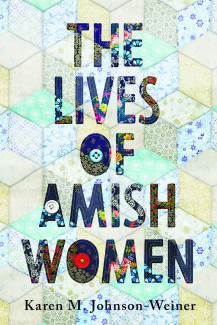
Johns Hopkins UniversityEst. 1876
America’s First Research University
Now Browsing:
The Lives of Amish Women

The Lives of Amish Women explores how religion, tradition, and social practice come together to shape what it means to be a woman in Amish society. In writing this book, I wanted to understand better how the religiously defined roles of Amish women have changed as Amish churches have evolved, to look at women’s lives and activities at different ages and in different communities, and to explore the relationship between changing patterns of social and economic interaction with mainstream society and women’s family, community, and church roles. What I learned was that Amish females become Amish women in different contexts, in different ways, and with different expectations.
One of the most enjoyable aspects of my research was talking and working with women and watching their children. In fact, I’ve learned much from children who are growing up to be Amish. Just this week, I visited with a mother with three-year-old twin boys (also six older children and one-year-old twin daughters!). I was wearing a white long-sleeved tee-shirt and an open, dark-colored cardigan, and one of the twin boys asked me, in Pennsylvania Dutch, if I’d just come from church. The question caught me off guard, for surely, this little boy, whose parents are members of one of the most conservative Amish affiliations, had not seen English (non-Amish) folks at church. His mother laughed and explained that my white shirt looked to her son like a white cape, and since Amish women wear white capes to church, and I appeared to be wearing a white cape, I’d clearly just come from church. That I wasn’t wearing a covering didn’t seem to matter, for he’d often seen women with their caps off, redoing their hair. So the cape was a marker of church in a way that coverings are not, and this three-year-old had already internalized it.
The little boy’s eight-year-old cousin, on the other hand, was quite focused on hair when I stopped by a couple of days later. She had taken out the elaborate braids little girls her age wear in this Amish community and was waiting for her mother to redo them. In the meantime, she had gotten some of her mother’s hairpins and was playing at putting her hair up in a bun, something she will not be permitted to do for real until she’s much older. Just as my own daughter at her age had played with jewelry and make-up to pretend to be a grown-up, this little girl played with her hair, adopting the hairstyle of the older girls.

I’ve found that children’s games hint at the internalization of a community’s values and social practices. In The Lives of Amish Women I talk about watching children play church, with little girls clutching dolls while their brothers mimic preaching. I also talk about children dressing up, with little girls using scarves or blankets to mimic the capes worn by older girls and adult women, while their brothers glue cornsilk to their chins with honey to have beards. Traditionally, Amish children are included in family and church-community events from birth and begin doing chores as soon as they are able to put a piece of wood in the wood box, taking on adult tasks well before adulthood. On Amish farms, children grow up working with parents and grandparents gradually learning not only to do the tasks that will sustain them economically, but also the values and appropriate behavior of Amish men and women and church members.
But I’ve also learned that games change as Amish communities cease to be agrarian, and families no longer come together to share labor and get large tasks done. After all, when Amish adults establish home businesses catering to the English world or leave the community to work for wages in non-Amish factories, hotels, and offices, men and women no longer work together across generations in the same way. New technology makes work both more independent and more specialized. Schools become more important because children can’t learn the diverse and often specialized skills they will need as adults by working with their parents and grandparents.
In The Lives of Amish Women, I explore these changes to understand what it means to be a woman in Amish society today. As the book makes clear, there are commonalities, for all Amish women’s lives are marked by church meetings, baptism, eight grades of schooling, horse-and-buggy transportation, plain dress, and the German language. But, at the same time, Amish groups are diverse, and while they use similar language to talk about themselves, they are not necessarily saying the same thing. Does “being humble” mean the same thing to the Amish woman who owns a business that reaches a national clientele as it does to the Amish woman who sells handmade potholders at a farm stand or to the stay-at-home Amish mother whose husband brings home a paycheck from a factory job? That’s what The Lives of Amish Women explores.
Order The Lives of Amish Women – published on September 15, 2020 – at the following link: https://jhupbooks.press.jhu.edu/title/lives-amish-women
Karen M. Johnson-Weiner is a Distinguished Service Professor Emerita of anthropology at SUNY Potsdam. She is the author of The Lives of Amish Women, Train Up a Child: Old Order Amish and Mennonite Schools, and New York Amish: Life in the Plain Communities of the Empire State and a coauthor of The Amish.

One of the most enjoyable aspects of my research was talking and working with women and watching their children. In fact, I’ve learned much from children who are growing up to be Amish. Just this week, I visited with a mother with three-year-old twin boys (also six older children and one-year-old twin daughters!). I was wearing a white long-sleeved tee-shirt and an open, dark-colored cardigan, and one of the twin boys asked me, in Pennsylvania Dutch, if I’d just come from church. The question caught me off guard, for surely, this little boy, whose parents are members of one of the most conservative Amish affiliations, had not seen English (non-Amish) folks at church. His mother laughed and explained that my white shirt looked to her son like a white cape, and since Amish women wear white capes to church, and I appeared to be wearing a white cape, I’d clearly just come from church. That I wasn’t wearing a covering didn’t seem to matter, for he’d often seen women with their caps off, redoing their hair. So the cape was a marker of church in a way that coverings are not, and this three-year-old had already internalized it.
The little boy’s eight-year-old cousin, on the other hand, was quite focused on hair when I stopped by a couple of days later. She had taken out the elaborate braids little girls her age wear in this Amish community and was waiting for her mother to redo them. In the meantime, she had gotten some of her mother’s hairpins and was playing at putting her hair up in a bun, something she will not be permitted to do for real until she’s much older. Just as my own daughter at her age had played with jewelry and make-up to pretend to be a grown-up, this little girl played with her hair, adopting the hairstyle of the older girls.

I’ve found that children’s games hint at the internalization of a community’s values and social practices. In The Lives of Amish Women I talk about watching children play church, with little girls clutching dolls while their brothers mimic preaching. I also talk about children dressing up, with little girls using scarves or blankets to mimic the capes worn by older girls and adult women, while their brothers glue cornsilk to their chins with honey to have beards. Traditionally, Amish children are included in family and church-community events from birth and begin doing chores as soon as they are able to put a piece of wood in the wood box, taking on adult tasks well before adulthood. On Amish farms, children grow up working with parents and grandparents gradually learning not only to do the tasks that will sustain them economically, but also the values and appropriate behavior of Amish men and women and church members.
But I’ve also learned that games change as Amish communities cease to be agrarian, and families no longer come together to share labor and get large tasks done. After all, when Amish adults establish home businesses catering to the English world or leave the community to work for wages in non-Amish factories, hotels, and offices, men and women no longer work together across generations in the same way. New technology makes work both more independent and more specialized. Schools become more important because children can’t learn the diverse and often specialized skills they will need as adults by working with their parents and grandparents.
In The Lives of Amish Women, I explore these changes to understand what it means to be a woman in Amish society today. As the book makes clear, there are commonalities, for all Amish women’s lives are marked by church meetings, baptism, eight grades of schooling, horse-and-buggy transportation, plain dress, and the German language. But, at the same time, Amish groups are diverse, and while they use similar language to talk about themselves, they are not necessarily saying the same thing. Does “being humble” mean the same thing to the Amish woman who owns a business that reaches a national clientele as it does to the Amish woman who sells handmade potholders at a farm stand or to the stay-at-home Amish mother whose husband brings home a paycheck from a factory job? That’s what The Lives of Amish Women explores.
Order The Lives of Amish Women – published on September 15, 2020 – at the following link: https://jhupbooks.press.jhu.edu/title/lives-amish-women
Karen M. Johnson-Weiner is a Distinguished Service Professor Emerita of anthropology at SUNY Potsdam. She is the author of The Lives of Amish Women, Train Up a Child: Old Order Amish and Mennonite Schools, and New York Amish: Life in the Plain Communities of the Empire State and a coauthor of The Amish.

Login to View & Leave Comments
Login to View & Leave Comments


